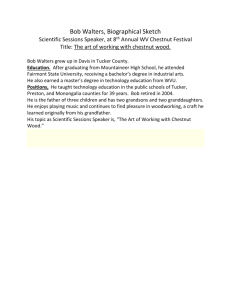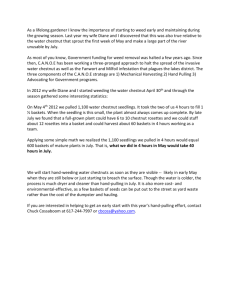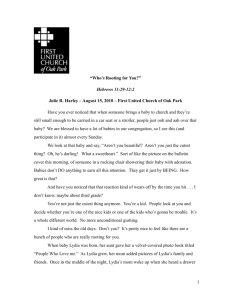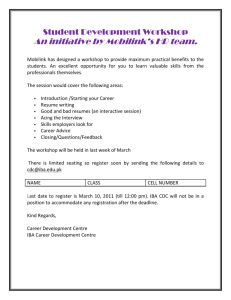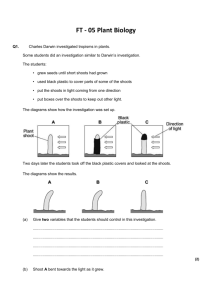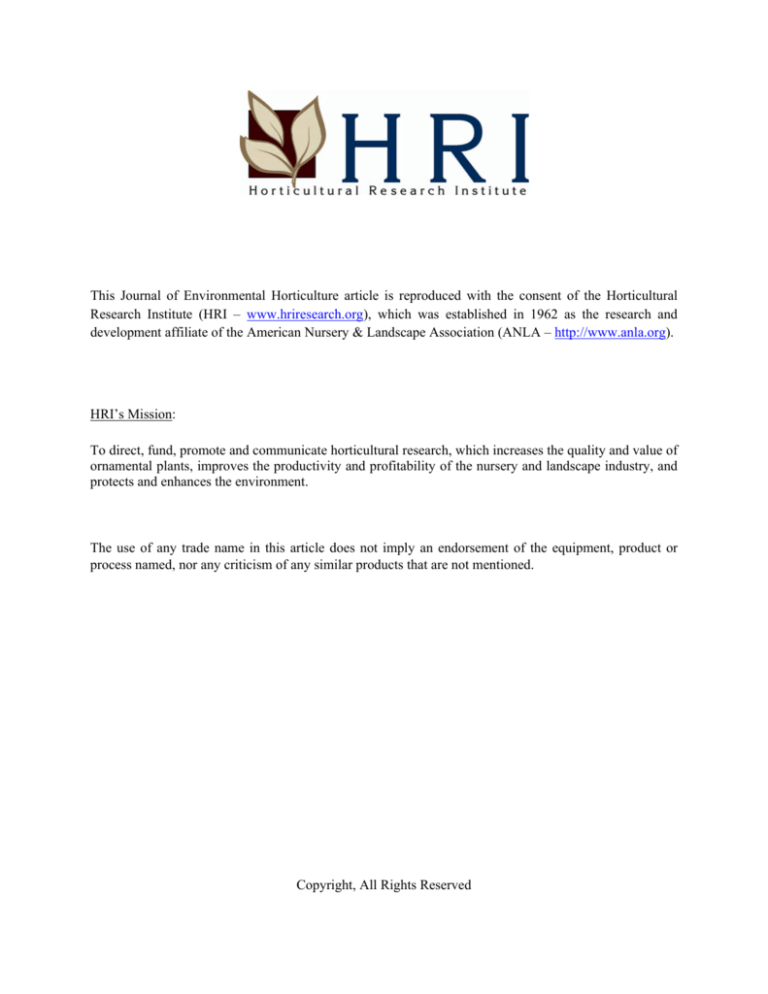
This Journal of Environmental Horticulture article is reproduced with the consent of the Horticultural
Research Institute (HRI – www.hriresearch.org), which was established in 1962 as the research and
development affiliate of the American Nursery & Landscape Association (ANLA – http://www.anla.org).
HRI’s Mission:
To direct, fund, promote and communicate horticultural research, which increases the quality and value of
ornamental plants, improves the productivity and profitability of the nursery and landscape industry, and
protects and enhances the environment.
The use of any trade name in this article does not imply an endorsement of the equipment, product or
process named, nor any criticism of any similar products that are not mentioned.
Copyright, All Rights Reserved
Rooting of American Chestnut Microcuttings 1
Rod Serres", Paul Read 3 , Wesley Hackett", and Per Nissen"
Department of Horticultural Science
University of Minnesota
St. Paul, MN 55108
r------------------
Abstract
----------------~
A pro~ed~re f~r micr~propagati.on of ~merican chestnut (Castanea dentata (Marsh.) Borkh.) seedlings was devised and three factors
a.ffectIng 111 Vlt~O ro~tIng were investigated. A two-step rooting procedure is utilized with a short term exposure to the auxin, IBA
(Ind.ole-3-butY~IC acid), c~lled t~e pulse treatment fo.llowed by transfer to an auxin-free medium called the rooting treatment.
Optimum !"ootIng was at~aIned ~Ith an. IBA c.oncentratIon of 369 ~M, a sucrose concentration of 40/0 (w/v) and half strength WPM
basal medIu~ concent~atlon. This rootIng regimen should enhance vegetative propagation techniques needed for rapid multiplication
of selected disease-resistant trees.
Index words: micropropagation, chestnut, IBA, sucrose, basal medium
Significance to the Nursery Industry
Selected resistant American chestnut trees would be de­
sirable for urban planting, nut production and possibly tim­
ber plantations. Breeding programs involving hybridization
with the Chinese chestnut and backcrossing to the American
chestnut are in progress (1). The introduction of selected
resistant American chestnut will rely on rapid and reliable
vegetative propagation techniques for screening programs
and distribution of the superior clones.
This work shows that the American chestnut can be suc­
cessfully propagated using micropropagation techniques. It
should be noted, however, that the source tissue used was
derived from juvenile plants and adaptations to the proce­
dure presented here may be necessary for success with plant
material taken from a selected mature tree.
(Ed. note: This paper reports the results of research only,
and does not imply registration of a pesticide under amended
FIFRA. Before using any of the products mentioned in this
research paper, be certain of their registration by appropriate
state and/or federal authorities).
Introduction
The American chestnut, Castanea dentata (Marsh.) Borkh.,
relinquished its role as one of the most important forest tree
species of the United States in the early 1900's (2). Chestnut
blight, a fungal disease, decimated the population. Origi­
nally comprising 25% of the trees in the Eastern forests,
the decline was dramatic and relatively fast, spanning only
about 50 years (1900-1950). The pathogen, Cryphonectria
I Received for publication November 1989; in revised form January 29,
1990. This research supported in part by the American Chestnut Foun­
dation, The Fulbright Foundation, The Magenta Corporation, Nestle Norge
Corporation, Torske Klubben Foundation, U.S. Forest Service-NCFES,
The Univ. of Bergen Norway, Univ. of Minnesota, and the Univ. of
Wisconsin.
2Research Assistant and to whom correspondence should be sent. Current
address: Department of Horticulture, University of Wisconsin, Madison,
WI 53705.
3Professor and Department Head, Department of Horticulture, University
of Nebraska, Lincoln, NE 68583.
"Professor. Department of Horticultural Science, University of Minnesota,
St. Paul, MN 55108.
5 Professor, Department of Botany, The Agricultural University of Norway,
N-1432 Aas-NLH, Norway.
86
parasitica (Murr.) Barr (formerly Endothia parasitica (Murr.)
And.), is thought to have been introduced to North America
in the late 1800's on Asiatic chestnut tree stock or wood
products (10).
Blight-resistant American chestnut trees are being de­
veloped for re-establishment in the forest and urban envi­
ronments (1 , 2). Conventional breeding programs underway
are hampered by difficulties with vegetative propagation of
C. dentata and interspecific hybrids (1, 2); however, veg­
etative propagation success is possible (8). The use of auxin
treatments greatly enhanced progress in the rooting of cut­
tings, but even then, mature chestnuts are difficult to prop­
agate vegetatively (3).
In vitro culture systems have been utilized by a few groups
to try to overcome this problem. Most research has been
conducted with Castanea sativa Mill., the European chest­
nut. Some tissue culture work has been done on the Amer­
ican chestnut but not dealing with the rooting of microcuttings
(5, 6, 9). Thorough reviews of tissue culture work with
Castanea are offered by Hansman (4) and Vieitez (13).
In vitro multiplication has been successful for many ju­
venile clones of C. dentata and its hybrids; however, rooting
has proven difficult. In this paper, the results of investi­
gations leading to the optimization of various factors for an
in vitro rooting system will be presented.
Materials and Methods
American chestnut seeds collected from a tree growing
in an isolated group were germinated in the greenhouse in
February. The apical 4-7 em (1.5-2,75 in) of the shoots
including the shoot tip and three developed nodes and in­
ternodes were excised from the greenhouse-grown seedlings
in mid-July. The leaves and stipules were removed and the
defoliated shoots were placed in a 1% commercial bleach
solution (0.05% NaOCl) with three drops Tween 20/1. In
the laboratory, the shoots were soaked for 10 minutes in a
100/0 commercial bleach solution (0.5% NaOCl) plus three
drops Tween 20/1. After the bleach soak and in a laminar
flow hood, the shoots were rinsed with sterile water, rinsed
with 70% ethanol for 30 sec., and finally rinsed three times
with sterile water to remove the ethanol. The shoots were
then cut into the 3 nodal sections and the tip. These were
cultured on 10 ml woody plant medium (WPM) (11) supJ. Environ. Hort. 8(2):86-88. June 1990
plemented with 0.54 IJ-M naphthaleneacetic acid (NAA) and
1.3 IJ-M benzyladenine (BA), 2% sucrose (w/v), and 0.650/0
(w/v) agar in culture tubes. The pH was adjusted with KOH
to 5.6 prior to adding agar. All cultures were kept under a
16 hr light (34 urnol sec - 1 m - 2)/8 hr dark photocycle at
20-24°C (70-75°F) in Conviron growth cabinets (Con­
trolled Environments, Winnipeg, Canada). Swelling of the
axillary buds and growth of the shoot tip were noted within
two weeks. The macronutrient, and vitamin components of
WPM will be referred to as the basal medium.
After 6 weeks on the initial medium, shoots from axillary
buds and shoot tips were approximately 6 ern (2.4 in) tall
with little branching. Nodal sections were subcultured onto
multiplication medium, that differed from the initiation me­
dium with BA (0.85 IJ-M) and agar (0.6% w/v). Every 5
weeks shoots were excised from their call used nodal bases
and the leaves were removed. These shoots were subdivided
into 1-3 node explants for continued multiplication. The
explants were laid on their sides with the proximal end
slightly depressed into the mediun1. The culture vessels were
either baby food jars with a volume of 170 ml capped with
Magenta b-caps (Magenta Corp., Chicago IL) or 'Magenta
GA7 and GA 7-3 vessels 500 ml and 300 n11 in volume
resp. Baby food jars were filled with 25 ml of medium upon
which 3 explants were placed. The GA 7 and GA 7-3 vessels
were filled with 50 ml of medium upon which 5 explants
were placed. None of the lids on the vessels were sealed
with parafilm.
After 7 months of continuous culture, stable multiplica­
~ion rates were attained, and experiments to develop a root­
mg strategy were begun.
General rooting procedure. Based on previous work with
other chestnut species and non-related woody species, the
following procedure for in vitro rooting of American chest­
nut was used and experimentally modified and will be re­
ferred to as the general rooting procedure. Shoots from 4­
week old multiplication cultures were used for all rooting
experiments. The shoots were approximately 2 ern (0.75 in)
long and had 3-4 nodes and the shoot tip. All leaves were
removed except for 1-2 small leaves at the tip. If not re­
moved, the leaves often grew very large when in contact
with the medium and forced the shoot base into the air.
To initiate rooting, the base of the cutting was exposed
to IBA (indole-3-butyric acid) at various concentrations.
This exposure will be referred to as the pulse treatment.
The standard pulse treatment lasted 5 days under conditions
described for multiplication. The standard pulse medium
consisted of half strength WPM basal medium, 4% (w/v)
sucrose, 0.44 IJ-M BA, and 123 IJ-M IBA. The pH was
adjusted to 5.6 with KOH. No agar was used. The shoots
were held upright in Magenta GA7-3's containing 50 ml of
liquid medium by being inserted into drilled holes in the
top of a Magenta b-cap fit into the GA 7-3.
After the pulse treatment, each cutting was transferred to
an individual glass culture vial containing 15 ml of the stan­
dard rooting medium which was the same as the pulse me­
dium except that it was solidified with 0.6% (w/v) agar and
contained no growth regulators. The cultures were incubated
in 24 hour darkness at 22°C (72°F). This treatment will be
called the standard rooting treatment.
Three factors were investigated for optimizing the general
rooting procedure: IBA concentration in the pulse treatment,
J. Environ. Hort. 8(2):86-88. June 1990
sucrose concentration in the rooting treatment, and basal
medium concentration during both treatments. All other
conditions were as described above as standard conditions.
lBA concentration. Three IBA concentration (49, 123,
or 369 IJ-M) were used during the pulse treatment. Each
IBA concentration was represented by 30 shoots with all 90
shoots in a completely randomized design.
Sucrose concentration. Three sucrose concentrations (1%,
2%, or 40/0 (w/v)) in the rooting treatment were investigated.
Each sucrose concentration was represented by 30 shoots
with all 90 shoots in a completely randomized design.
Basal medium concentration. Two basal medium con­
centrations (full- or half-strength) were used in both the
pulse and rooting treatments. Each basal medium concen­
tration was represented by 30 shoots with all 60 shoots in
a completely randomized design.
Results and Discussion
The bases of the cuttings became slightly swollen during
the pulse treatment and continued to swell with some callus
growth during the rooting treatment. Roots were evident
about 2 weeks after the beginning of the pulse treatment.
More roots developed in the following weeks, and roots
reached a length of 10 em (4 in) in 4 weeks. Apical necrosis
was evident on some shoots at 2 weeks, and the number of
shoots affected increased with time. Necrosis was generally
limited to the shoot tip, rarely exceeding the top node and
therefore 2 nodes and axillary buds remained viable. These
buds produced the shoots that allowed survival of the rooted
cutting.
The highest concentration of IBA investigated (369 IJ-M)
gave the highest percentage rooting and the greatest number
of roots per shoot (Table 1 and Fig. 1). Higher concentra­
tions of IBA were investigated in preliminary experiments
with C. dentata but over-production of callus and increased
tip necrosis resulted.
Sucrose concentration in the rooting medium was posi­
tively correlated with rooting percentage (Table 2). The
number of roots per shoot also increased with sucrose con­
centration (Fig. 2) and there were significant differences in
root number amon~ all three sucrose concentrations. Higher
sucrose concentrations should be investigated.
A decrease in the basal medium concentration enhances
both the percentage rooting (Table 3) and the number of
roots per shoot (Fig. 3). Preliminary experiments (data not
shown) indicated, however, that if no basal medium (just
agar and sucrose) is used during the rooting treatment no
rooting occurs and the microcutting dies.
Table 1. Effects of IBA concentration on the percentage rooting of
American chestnut microcuttings.
Percentage of shoots with roots
Treatment
49 J.LM IBA
123 J.LM IBA
369 J.LM IBA
3 weeks
4 weeks
6.7a/
66.7b
63.3b
51.7a
93.3b
93.3b
zYalues within a column not followed by the same letter or letters are
significantly different using a chi-square analysis.
87
15
Table 2. Effects of sucrose concentration on the percentage rooting
of American chestnut microcuttlngs,
10
Treatment
3 weeks
4 weeks
1% sucrose
2% sucrose
4% sucrose
6.7a
40.0b
73.3c
23.3a
56.7b
80.0c
~
0
0
::r::
Percentage of shoots with roots
(f)
a:::
w
D....
(f)
~
0
0
a:::
LL
5
0
a:::
<Values within a column not followed by the same letter or letters are
significantly different using a chi-square analysis.
w
rn
~
::)
z
0
49
123
369
Table 3. Effects of basal medium concentration on the percentage
rooting of American chestnut microcuttings.
IBA CONCENTRATION IN PULSE (uM)
Fig. 1. Influence of IBA concentration in the pulse on the number
of roots per shoot at 4 weeks. Each bar represents the mean
± S.E. of 30 shoots except 49 f.LM BA which had 29 shoots.
20...,....------------------------,
~
0
0
a:::
63.3a
80.0a
73.3b
Rooted microshoots have successfully acclimated to
greenhouse conditions.
D....
(f)
0
0
4 weeks
33.3a z
15
w
~
Full basal medium
Half basal medium
3 weeks
zYalues within a column not followed by the same letter or letters are
significantly different using a chi-square analysis.
::r::
(f)
Percentage of shoots with roots
Treatment
10
a:::
1.L
Literature Cited
0
a:::
w
5
I. Burnham, C.R., P.A. Rutter, and D.W. French. 1986. Breeding
blight-resistant chestnuts. Plant Breeding Rev. 4:347-397.
CD
~
::)
z
0
3.0
2.0
1.0
SUCROSE CONCENTRATION (%)
Fig. 2. Effect of sucrose concentration in the rooting medium on the
number of roots per shoot at 4 weeks. Each bar represents
the mean ± S.E. of 30 shoots.
20
~------------------------,
~
0
0
a:::
15
w
D....
~
10
a:::
1.L
w
5
0
9. Keys, R.N. and F.C. Cech. 1979. Growth and differentiation of
American chestnut callus cultures. Conf. Proc. 26th North-Eastern Forest
Tree Improvement, Penn. State University. pp. 13-24.
CD
~
::)
z
0.5X
1.0X
BASAL MEDIUM (WPM) CONCENTRATION
Fig. 3. Effect of woody plant basal medium concentration in the pulse
and rooting media on the number of roots per shoot at 4
weeks. Each bar represents the mean ± S.E. of 30 shoots.
The sucrose and basal medium concentrations are appro­
priate and the lBA pulse concentration should be at least
123,.....M.
In vitro rooting of American chestnut is significantly af­
fected by the 3 factors investigated here. The effects of
these 3 factors on in vitro rooting have been studied for
other plant species (7, 12, 14) and the results were similar
to those presented for the American chestnut.
88
5. Hebard, F.Y. and P.B. Kaufman. 1976. Studies of chestnut in vitro.
Plant Physiol., 57 (5, supplement), 88 [abstract No. 458].
8. Keys, R.N., 1978. Prospects for vegetative propagation in the genus
Castanea. In: Proceedings of the American Chestnut symposium: Jan. 4­
5, 1978. Morgantown, WY .. West Virginia University Books. pp. 10­
16.
0
a:::
4. Hansman, D. and C. Owens y de Novo. 1986. Micropropagation of
temperature nut trees. Intern. Hort. Abst. 56(6)403-416.
7. Hyndman, S.E., P.M. Hasegawa and R.A. Bressan. 1982. The role
of sucrose and nitrogen in adventitious root formation on cultured rose
shoots. Plant Cell Tissue Organ Cultue. 1:229-238.
(f)
0
0
3. Elkins, J.R., B.J. Given, E. Yieitez, G. Bazzigher, and G. Griffin.
1980. Vegetative propagation of large, surviving American chestnut trees.
North. Nut Growers Assoc. Ann. Rept. 71 :56-62.
6. Hu, C. and E.C. Scrivani. 1977. Effect of kinetin on callus mor­
phogenesis from stem apex explants of American chestnut (Castanea den­
tata) winter buds. Plant Physiol., 59(6 suppl.):2.
::r::
(f)
2. Burnham, C.R. 1988. The restoration of the American chestnut.
Amer. Scientist 76:478-487.
10. Kuhlman, E.G. 1978. The devastation of the American chestnut by
blight. In: Proceedings of the American Chestnut Symposium, Morgan­
town, West Ya., Jan. 4-5. pp. 1-3.
II. Lloyd, G. and B.H. McCown. 1981. Commercially feasible mi­
cropropagation of mountain laurel (Kalmia latifoliai by use of shoot tip
culture. Proc. Intern. Plant. Prop. Soc. 30:421-427.
12. Rodriguez, R., 1982. In vitro propagation of Castanea sativa Mill.
through meristem-tip culture. HortScience 17:888-889.
13. Yieitez, A.M., M.L. Yieitez. and E. Yieitez. 1986. Chestnut (Cas­
tanea spp.). In: Biotechnology in Agriculture and Forestry Yol I: Trees I
(Y.P.S. Bajaj ed.) Springer-Verlag. pp. 393-414.
14. Yang, Q.G., P.E. Read, C.D. Fellman. and M.A. Hosier. 1986.
Effect of cytokinin, IBA, and rooting regime on chinese chestnut cultured
in vitro. HortScience 21: 133-134.
J. Environ. Hort. 8(2):86-88. June 1990

